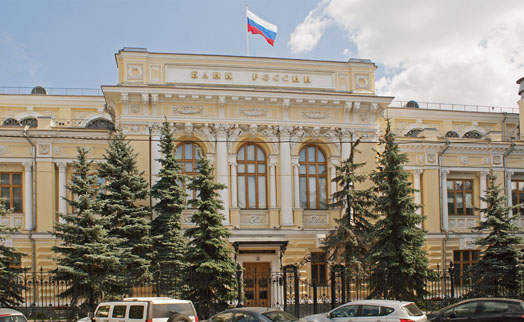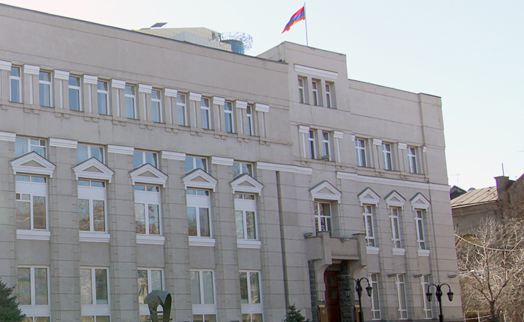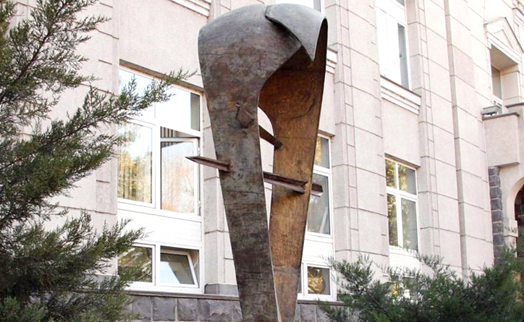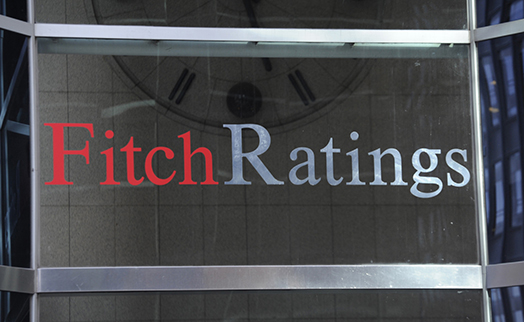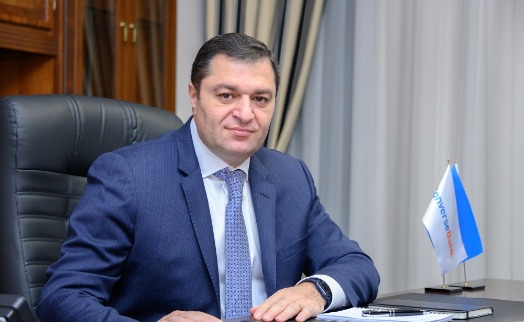18.01.2010 14:06

Exclusive interview of Arthur Javadian, chairman of Armenian Central Bank, to ARKA news agency
ARKA: Mr. Javadian, does the Central Bank plan to revise its fiscal and credit policy as part of a budget that was developed amid the ongoing global crisis and what steps does it plan to take to make its policy as effective as possible under the current economic conditions?
Arthur Javadian: Armenia’s economic growth prospects changed drastically after October 2008 when the global crisis became to deepen hitting severely the economies of Armenia’s major economic partners.
This forced the Central Bank to reconsider the main direction of its fiscal and credit policies (which, prompted by an effective correlation of stable prices and economy stimulating tasks, was as expansionary as possible), through lowering the refinancing rate (it fell by 2.75 percentage point from the second quarter of 2009) and increase of volumes.
To back the move we supplemented the money and credit instruments by new long-term credit tools, offering banks three-month REPO contracts. At the same time as part of government’s anti-crisis measures, about 23 billion Drams from the Russian stabilization loan were distributed.
In a bid to ensure the financial stability, the banks are offered long-term subordinate loans, repayable in 5 years, to increase their capital. If they want to merge they may get a loan in the amount of 30% of their merged capital repayable in 3 years.
In the light of money and budget policy, reflected in the draft law on State Budget of Armenia for 2010, the Central Bank will continue the implementation of effective money and credit policy to promote a quick economic recovery through above-mentioned tools and without threatening price stability.
ARKA: What are Central Bank’s forecasts about the exchange rate of the national currency Dram? Are there mechanisms to ensure a more flexible exchange rate behavior?
Arthur Javadian: Since regulation of the exchange rate is not a goal of money and credit policy, Central Bank refrains from official comments on USD exchange rates. The NASDAQ OMX Armenia exchange stock has been operating in Armenia about 4 years allowing participants of forex market to follow online forex trading and take part in it. This gives flexibility to forex market. Nevertheless we have a problem which is the small Armenian market.
Short-term but massive flows lead to sharp fluctuations at forex market. Attraction of more forex market participants, development of derivative instruments may help solve this problem.
ARKA: The Central Bank implemented a series of interventions of late in the forex market? What has prompted them and does it mean a return to the fixed exchange rate pf Dram?
Arthur Javadian: In Armenia we have the floating exchange rate, which is not an objective of the Central Bank management. Interventions in the forex market are made and will be made to prevent sharp fluctuations.
ARKA: How would you comment on Armenia’s inflation rate as opposed to inflation rates in other CIS countries. What are Central Bank’s forecasts about 2009 full-year inflation rate and will it be possible to preserve within the projected targets?
Arthur Javadian: In August the inflation rate was 2.1% as opposed to the beginning of the year, while in some CIS countries, particularly, in Russia it rose to 8.1%, in Belarus to 7.5%, in Ukraine to 8.2%, in Kazakhstan to 4.3%, in Georgia to 2.1%, in Kyrgyzstan to 1.9% and in Tajikistan to 3.4%. According to official statistical data, at the end of September 2009 the 12-month inflation rate was 3.7%, which was within the projected targets. According to Central Bank estimates, the full-year inflation will be within permissible 4% (±1,5%).
ARKA: From 2009 March the Central Bank has been conducting the policy of lowering refinancing rate, hailed by IMF and World Bank experts, who recommended that this policy continues. But there is a reasonable limit. For example, the European Central Bank is against setting zero interest rate. What is the best rate for Armenia in current conditions?
Arthur Javadian: Indeed, we began lowering refinancing rate from the second quarter of 2009, reducing it overall so far by 2.75 percentage point. The move was largely prompted by quick economic decline and low internal inflation environment, formed under the influence of external factors.
We do not think there is a reasonable limit of interest rates that could be applied in any country at any time. Best rates should be considered in a specific context. Any decision to change refinancing rate is based on inflation, market and exchange rates, economic activity and analysis of some macroeconomic indices.
It also takes into account inflation and economic growth forecasts for the following time period.
According to Central Bank estimates, some stabilization trends have been already fixed and this is why we think the current refinancing rate of 5% is the best one to promote quick economic recovery without jeopardizing price stability.
ARKA: How would you describe the performance of commercial Armenian banks in conditions of crisis? Do we have problem banks now?
Arthur Javadian: Armenian banking system began to feel the impact of the global financial-economic crisis from Q4 of 2008. Capitalization and adequacy levels of Armenian banking system are quite high compared to banking systems of other countries.
This is why an insolvency problem is little probable, since banks are able to cover potential losses from financial risks by their own means, without having to ‘borrow’ from their clients.
As a result the capital/assets ratio of the banking system is 21.2%, while the capital adequacy normative index is 28.4%. By the way, the capital adequacy index exceeds significantly the required minimum 12% level. Today we do not have problem banks. All of them perform within the frames of permissible risks.
As for their performance in conditions of financial and economic crisis, the banks have become more cautious, particularly, in crediting policies, reflected in a more careful study of borrowers’ financial standing and records. Concurrently borrowers have also become cautious, as in the long-term perspective part of them are uncertain about their future profits.
ARKA: Do you think commercial banks are likely to lower interest rates in near future and if yes, how much?
Arthur Javadian: As interest rates are formed by the market we do not make forecasts about their future, but this does not mean we do not rule out their lowering. Nonetheless, the Central Bank undertook and is undertaking certain steps towards making low interest credits accessible. Particularly, the Central Bank has lowered refinancing rate (REPO), carrying out concurrently a three-month REPO, proving also banks with long-term targeted loans within the frameworks of international programs for further on-lending at as lower interest rates as possible.
ARKA: Do you expect emergence of new banks or merger of operating ones?
Arthur Javadian: The Central Bank does not possess information about the opening of a new or merger of operating banks. However, mergers are not excluded in future because there are backstage talk about negotiations over possible mergers. Since the Central Bank supports consolidation and merger of banks, it will show assistance in case of any such initiative.
ARKA: How could you assess the situation at credit market and is there a credit portfolio growth dynamic?
Arthur Javadian: Over the recent months we have been seeing this market to step up. Thus, in 2009 Q 3 the volume of credits rose by 45 billion Drams. Overall the volume of credits extended by commercial banks in the first 9 months of 2009 grew by 7%.
The growth is driven by banks’ and borrowers’ expectations of profit stabilization, extensive policy of the Central Bank as well as credits, allocated by the government through banks as part of different programs such as the German-Armenian mortgage program, the business support program backed by funds from the Russian stabilization loan.
ARKA: How would you asses a World Bank loan program for supporting small and medium businesses? How much of it was allocated to banks and how many banks applied for on-lending?
Arthur Javadian: Eight banks were selected to carry out the program and six of them have already extended 2.5 billion Drams worth credits.
ARKA: Do you expect interest rate changes in the securities market any time soon and if yes what will be behind it?
Arthur Javadian: Interest rates at the securities market are influenced largely by issuance of state bonds, demand of commercial banks for such bonds, the Central Bank-set refinancing rate as well as banks’ expectations. In view of the fact that the Central Bank has left the refinancing rate unchanged at 5%, no tangible change of interest rates at this market is expected in the foreseeable future. We would like to also add that Dram liquidity is very high which in turn supports high demand for state bonds.
ARKA: Does the National Mortgage Company plan to increase its capital and does the government plan to cut its share in its capital in the near future?
Arthur Javadian: The National Mortgage Company is likely to increase capital concurrently with growing volume of credit portfolios. Today its charter capital is 5 billion Drams. As for the share of the government in it, we would like to note that its activity is based on so-called PPP principle (private public partnership).
In accordance with it the government is expected to cut its share at the expense of private investments.
ARKA: Recently the government took a decision to issue government bills to zero the accumulated losses of the Central Bank. What is the volume of the issue and when the government plans to issue and redeem them?
Arthur Javadian: In accordance with Article 11 of the Law on Central Bank of the Republic of Armenia, if the losses accumulated on Central Bank balance within one financial year exceed the total of reserves, the government has to issue interest-free call bills in the amount not exceeding the total within 30 days since the moment of balance publication and provide them to the Central Bank as capital investments.
Guided by this provision the government has provided the Central Bank with such a bill, however, we can talk about it only after summing the totals of the 2009.
It should be noted that on September 23, 2009 the government approved a draft law on making changes to the Law on Central Bank of the Republic of Armenia, in accordance with which the government provides the Central Bank not with interest-free state call bills, but with the government-issued securities. Their placement and redemption is carried out at market prices.
The type of securities, as well as the order and terms of their provision, buyout, calculation and interest payment will be established in accordance with the agreement, to be signed by the government and Central Bank.
By the way, the draft law in question also stipulates that bills provided by the government earlier are to be replaced by government-issued securities. I would like to note that according to our forecasts by the end of 2009 the Central Bank loss is expected to reduce significantly.
ARKA: The All-Armenian Bank was registered by Central Bank. When is it going to start full operation and was a candidate chosen to head it?
Arthur Javadian: The All-Armenian Bank is still in the registration process. Currently government-recruited international experts are developing its plan of actions and considering a candidate to serve as its executive director.
ARKA: How real is the 2010 budget performance and how productive the basic financial document is in conditions of the crisis?
Arthur Javadian: The 2010 budget is based on the vision of investment environment, improvement of tax and customs administration, support for infrastructure development as well as the need to continue anti-crisis measures, declared by government’s program of actions.
The government’s 2010 socio-economic policy is directed, particularly, at consistent implementation of anti-crisis measures, ensuring macroeconomic stability, deepening the social policy, supporting small and medium-sized businesses. This policy is reflected in appropriate provisions of the Law on State Budget.
Particularly, it has projected a 2.7% rise in tax collection rate, a 0.6% decline in spending and a 21.5% decline in deficit. In conditions of economic recovery in 2010 we believe that a precondition will arise to secure all above-mentioned proportions of the budget.
ARKA: How would you interpret the government’s refusal to include in the 2010 budget the Dram’s exchange rate against USD, as the practice was in the past.
Arthur Javadian: In accordance with Article 2 of the Law on Making Changes to the Law on Budget System, when drafting the government budget, the average exchange rate of Dram against appropriate hard currencies at local forex market on the first day of a month when the draft budget is submitted to parliament is used to calculate hard currency budget revenues and spending in Dram equivalent.
If revenues and spending in foreign currency is impossible to calculate at that exchange rate within a reasonable period of time, then the average exchange rate of Dram against appropriate hard currencies formed on the first day of the previous month is used. When in conditions of floating exchange rate it is impossible to accurately predict the exchange rate, the above-mentioned approach is most effective.
ARKA: Dou you agree with forecasts that the economy will grow by 1.2%-1.3% in 2010 and which are the sectors that are supposed to secure this growth?
Arthur Javadian: The Central Bank forecasts the economy to grow by 1% in 2010. This expectation is based on global economic recovery forecasts, including global demand growth, continued rise of international prices of metals, implemented and to be implemented government’s anti-crisis measures, as well as investments in different sectors of economy. By the way, the projected economic growth is supposed to be secured by virtually all sectors.
Particularly, we expect a 0.1% added value growth in industry, mainly, at the expense of anticipated growth in metallurgical and energy sectors. We expect also a 1.7% growth in construction sector, to be secured by construction in energy, transport and communications sectors. But we have to bear in mind the unprecedented decline in construction in 2009. We expect also agriculture and services to grow by 3.8% and 0.7% respectively.
ARKA: How productive cutting the budget revenue and spending will be in conditions of the crisis?
Arthur Javadian: The 2010 budget projects a 2.7% growth in tax revenues. At that the Taxes to GDP ratio will be preserved at the planned level of 16.6% with 0.6% spending cut. As a result we expect the deficit to GDP ratio to reduce by about 1.8 percentage point. In these conditions we welcome the government’s approach to gradual mid-term reduction of budget deficit, which is in tune with ensuring macroeconomic stability and mid-term economic growth.
At the same time it would be desirable to exercise more efforts to secure a significant rise in taxes/GDP ratio. This would allow to foresee serious financial resources for ensuring the continued implementation of anti-crisis measures, designed to boost economic growth.
In these conditions by preserving spending priorities we emphasize shifting to maximum saving regime with regard to some programs. -0-
Read the news first and discuss them in our Telegram
Tags:






